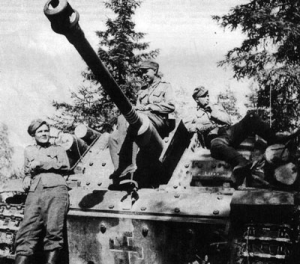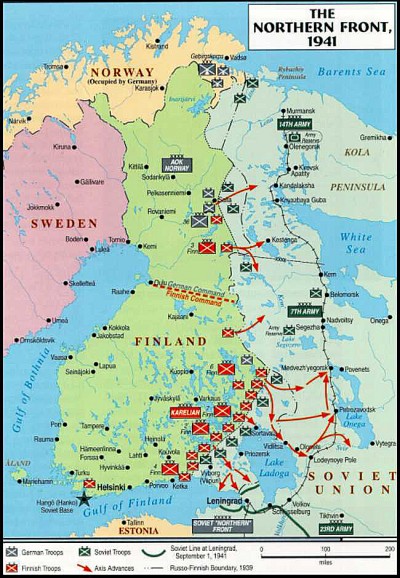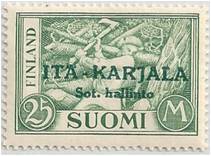ALBUM – view my East Karelia, Finnish Occupation album
TRANSITION CHART – North and West Russia (including Finland)
Fast Facts
Region: Russia Area
Group: Finnish Area
Classification: Military Occupation (Finland)
Prior Regime: Soviet Union (since 1939)
Key Dates:
1939, Nov 30 – Soviet Union attacks Finland, starting the Winter War
1941, Jun 25 – The Soviet Union attacks Finland, starting the Continuation War
1941, Jul 15 – East Karelia Military Administration (KMA) established
1944, Jul-Oct – Soviet Union recaptures Karelia, and KMA is disestablished
Following Regime: Soviet Union
Scott Catalogue: (Karelia) #N1-N27, NB1
Pick Catalogue: none
History

East Karelia is a territory on the borderlands of Finland and Russia, which was occupied by the Finns during World War 2, with the goal of annexing it into Finland. The area, which has been disputed for centuries, was a part of the Finland, when it was a Grand Duchy under the Russian Empire. With the fall of the Russian Empire in 1917, where Finland was a Grand Duchy since 1809, Finland became an independent nation. The official border as agreed at the Russian-Finnish Treaty of Tartu (1920) which included much of the Karelia region. After the end of the Russian Civil War, and the Soviet Union was established, the Russian part of Karelia became the Karelian Autonomous republic of the Soviet Union.
In 1939, with the coming of war in Europe, the Soviet Union, tried to obtain a naval base and some islands in the Gulf of Finland to defend potential attacks against Leningrad. The Finns refused, and the Soviet Union attacked Finland, and in what is known as the Winter War, overwhelmed Finland in a matter of months. As a result, Finland lost much of Finnish Karelia, and had to relocate 400,000 people (an eighth of the Finnish population) out of the conquered lands. This loss required Finland to relocate 400,000 people (an eighth of the Finnish population), out of the conquered lands. Unable to garner support from the UK and Sweden toward their plight, the Finns turned to the Germans. On 25 Jun, 1941, the Soviet Union launched another massive air raid against Finnish cities, after which Finland declared war and also allowed German troops stationed in Finland to begin offensive warfare. The resulting war was called the Continuation War. With the support of the Germans, the Finns attacked the Soviets in Karelia, retaking the territories lost in the Winter War. The Finnish army also advanced further, leading to the occupation of Russian East Karelia, which was never a part of Finland. This caused Great Britain to declare war on Finland on 6 Dec 1941. The Finnish Army took up defensive positions, and created the East Karelia Military Authority. This led to a long period of relative calm on the front line, which lasted until 1944.
 After the devastating defeat of the Germans at the Battle of Stalingrad in Feb. 1943, Finland began to see the outcome of war turning against them and begin seeking a way out. On 9 Jun 1944, the Red Army launched a massive attack against Finland. With vast numerical superiority, the Soviets caught the Finnish army by surprise, which led then to retreat to approximately the same positions as the Finns were holding at the end of the Winter War.
After the devastating defeat of the Germans at the Battle of Stalingrad in Feb. 1943, Finland began to see the outcome of war turning against them and begin seeking a way out. On 9 Jun 1944, the Red Army launched a massive attack against Finland. With vast numerical superiority, the Soviets caught the Finnish army by surprise, which led then to retreat to approximately the same positions as the Finns were holding at the end of the Winter War.
To assure continued support from the Germans, Finnish president Risto Ryti gave Germany his personal guarantee that Finland would not negotiate peace with the Soviet Union for as long as he was the president. After the Soviet invasion was halted, Ryti resigned. Due to the war, elections could not be held, therefore the Parliament selected the Marshal of Finland Carl Gustaf Emil Mannerheim, the Finnish commander-in-chief, as president and charged him with negotiating a peace. On 4 Sept 1944 a ceasefire was agreed, and an armistice signed shortly thereafter. The agreement required Finland to expel German troops which led to the Lapland War between Finland and Germany. This conflict lasted until the end of World War 2.
Stamps
 In July, 1941, the Military Administration of East Karelia was set up, and stamps were issued in the captured area. Definitive stamps of Finland featuring the Lion of Finland (1930-46) along with 3 pictorials were printed in different colors and overprinted: “ITÄ- / KARJALA / Sot.hallinto”, for “East Karelia Military Administration”. The overprints had two different typefaces and two colors (black and green).
In July, 1941, the Military Administration of East Karelia was set up, and stamps were issued in the captured area. Definitive stamps of Finland featuring the Lion of Finland (1930-46) along with 3 pictorials were printed in different colors and overprinted: “ITÄ- / KARJALA / Sot.hallinto”, for “East Karelia Military Administration”. The overprints had two different typefaces and two colors (black and green).
In 1942, the East Karelia Military Administration issued two additional sets of stamps. The issues again use designs from Finnish stamps, but printed in different colors and overprinted as before.
The first set of six stamps featured the image of Carl Gustaf Emil Mannerheim, the Chief of Defense of the Finnish Defense Forces during the Occupation of East Karelia. Mannerheim, a powerful figure in Finland, ultimately became the 6th Finnish President on 4 Aug 1944 after Risto Ryti resigned.
The second set, with the same colors and denominations as the Mannerheim stamps, depicted Risto Heikki Ryti, the President of Finland during the occupation. Ryti made a secret pact with the Germans in 1940, and led the country in the time of the Continuation War and the occupation of East Karelia. He was ultimately forced to resign, and later spent 10 years in prison for alleged “war crimes”.
The only stamp to be fully designed for the occupation was also its last; a semi-postal stamp issued in 1943, depicting the arms of the territory, and had a surcharge of 1.50 markka, which went to aid war victims.
Banknotes
None
Links
What is Karelia
Article in Helsingin Sonomat: Under Finnish Occupation




